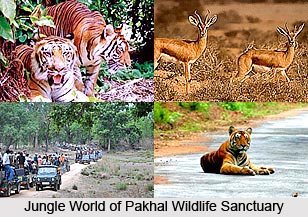 Pakhal Wildlife Sanctuary was established in the year 1952 and is located around 50 km away from the town of Warangal, in the state of Telangana. This town is located in Warangal District.
Pakhal Wildlife Sanctuary was established in the year 1952 and is located around 50 km away from the town of Warangal, in the state of Telangana. This town is located in Warangal District.
Location of Pakhal Wildlife Sanctuary
Pakhal Wildlife Sanctuary is located beside the Pakhal Lake, which is an artificial lake. Pakhal Wildlife Sanctuary is spread over a total area of 839 sq km and the area of Pakhal Lake is around 30 sq km. The area of Pakhal Wildlife Sanctuary consists of a large plateau bounded by low hill and is rich with diverse natural vegetation, which includes tropical dry deciduous mixed forests, mixed teak and bamboo forests. There are also various species of animals which can be found here. The natural picturesque magnificence and landscape of Pakhal Wildlife Sanctuary is extremely captivating and attracts several tourists through out the year.
History of Pakhal Wildlife Sanctuary
Pakhal Wildlife Sanctuary was established in the year 1952. The man-made Pakhal Lake, situated in the vicinity, was constructed during the first decade of the 13th century (1213 AD), by Ganapati Deva, the Kakatiyan Ruler. The name of Pakhal Wildlife Sanctuary was derived from the name of the person who excavated the lake
Geography of Pakhal Wildlife Sanctuary
The altitude of Pakhal Wildlife Sanctuary varies between 280-300 feet. The average temperature in the region varies from 15 degree Celsius to 45 degree Celsius. The average annual rainfall at Pakhal Wildlife Sanctuary is around 1,225 milimeters.
Pakhal Wildlife Sanctuary is located almost 50 km away from Warangal and the distance from Narsampet, the taluk headquarters, is about 12 km; while Hyderabad is around 112 km away. The area is well connected by roadways and regular bus services are available from Narsampet to Pakhal Wildlife Sanctuary. The nearest railway station is at Warangal.
Flora and Fauna of Pakhal Wildlife Sanctuary
The bio-diversity of Pakhal Wildlife Sanctuary is one of its key features. The area is covered with lush dense tropical deciduous forest which comprises of a variety of animals. The evergreen species consists of Mallotus Philippensis and Aegle Marmelos. Deciduous vegetation, which is mostly dominant, includes Adina Cordifolia, Bridelia Retusa, Bombax Ceiba, Cochlospermum Religiosum, Cleistanthus Collinus, Dalbergia Latifolia, Emblica Officinalis, Garuga Pinnata, Flacourtia Indica etc. The forest floor is covered with monsoon plants, shrubs and woody herbs as well.
Several species of wild animals are also found at Pakhal Wildlife Sanctuary such as Tiger, Leopard, Panther, Sloth Bear, Sambar, Chital, Nilgai, Chowsingha, Chinkara, Black Buck, Langur, Hyena, Wild Dogs, Wolf, Jackal, Porcupine, and Wild Boar. Various types of reptilian species like Python, Common Krait, Cobra, Crocodile and Monitor Lizard are also found here. Large numbers of migratory birds take shelter at Pakhal Lake from November to March.
The best time to visit Pakhal Wildlife Sanctuary is between November to June, as the temperature is pleasant during that period.











